Analysing the Spatio-Temporal Variations of Urban Street Summer Solar Radiation through Historical Street View Images: A Case Study of Shanghai, China
Abstract
:1. Introduction
- How can the distribution of urban street solar radiation over different temporal cross-sections be calculated using urban street view images from different years?
- What is the overall trend of changes in urban street solar radiation over time?
- Does the variation in urban street solar radiation in the inner and outer parts of a city exhibit consistency?
2. Background and Related Works
2.1. Time Series Street View Research
2.2. Solar Radiation in Urban Areas
2.3. Solar Radiation Simulation and Calculation
3. Methodology
3.1. Study Area and Data
3.2. Multi-Year Street View Data Collection and Seasonal Filtering
3.3. Fisheye Image Generation and Azimuthal Rotation
3.4. Calculating Solar Radiation over Many Years through Street Views
4. Results
4.1. Distribution and Trend of Solar Radiation over Time
4.2. Distribution of Solar Radiation in Geographic Space
4.3. Distribution and Trend of Solar Radiation Variations in Geography
5. Discussion
5.1. Interannual Differences in Street View Data and Data Quality
5.2. Summary of the Phenomenon and Implications for Development Policy
- Urban development policies need to emphasise the balance between greening and infrastructure construction. The shading effect of greenery can lower urban temperatures and alleviate the urban heat island effect. However, tree canopies may also hinder ventilation and contribute to the accumulation of emissions, affecting quality of life. We recommend rationally planning urban ventilation corridors, considering the impact of ventilation coefficients on cooling. Therefore, in the process of urban planning and development, it is crucial to consider the relationship between urban buildings, infrastructure, and greenery, and to correctly select parameters such as the location and spacing of trees, in order to maintain both the ecological environment and the comfort of human living conditions.
- Urban planning should fully consider the impact of solar radiation on renewable energy. With the development of cities and the growth of populations, the demand for energy is continuously increasing. Therefore, improving the utilisation rate of renewable energy is particularly important. By rationally arranging road solar photovoltaic power generation facilities to charge electric vehicles in transit, solar energy resources can be fully utilised, thereby enhancing the efficiency of solar energy use [47]. Additionally, the research findings have a certain reference value for architectural design and the selection of building materials. Based on the identification results, it is possible to provide early warnings for the energy consumption of buildings in specific areas, thereby achieving the goals of energy conservation and emission reduction.
- The practice of urban development policies should emphasise the coordination of internal and external urban development. The research results indicate that the reduction in solar radiation increases with the distance from the city centre, suggesting a potential imbalance between internal and external urban development. Therefore, policymakers should focus on the coordinated development of internal and external areas, rationally allocating urban resources and infrastructure. By reducing the solar radiation in city centres, the heat island effect can be mitigated, achieving overall sustainable urban development. The research results hold significant theoretical and practical value for guiding urban planning and construction, optimising urban infrastructure, and promoting sustainable urban development.
- Considering the specific applications of solar radiation in urban streets, solar radiation impacts not only the overall energy consumption and environmental temperature of cities but also directly influences residents’ comfort and the conduct of outdoor activities. High-intensity solar radiation can lead to excessively high street temperatures, affecting pedestrians’ comfort and health, and may even restrict the duration and frequency of outdoor activities. To address these issues, urban planning should consider the reasonable layout of shading facilities in street design, such as tree canopies, awnings, and pavilions, to reduce areas directly exposed to sunlight. Additionally, studying the heating effects of solar radiation on different materials can guide the selection of appropriate building and paving materials to lower street temperatures. Furthermore, optimising the spacing and orientation of buildings can enhance urban ventilation and lighting conditions, thereby improving the outdoor activity environment. These measures can not only improve the quality of life for residents but also promote the sustainable development of cities.
5.3. The Scientific Contribution of the Practical Approach
5.4. Research Limitations
6. Conclusions
Author Contributions
Funding
Institutional Review Board Statement
Informed Consent Statement
Data Availability Statement
Acknowledgments
Conflicts of Interest
References
- Han, X.; Wang, L.; Seo, S.H.; He, J.; Jung, T. Measuring Perceived Psychological Stress in Urban Built Environments Using Google Street View and Deep Learning. Front. Public Health 2022, 10, 891736. [Google Scholar] [CrossRef]
- Sallis, J.F.; Glanz, K. The Role of Built Environments in Physical Activity, Eating, and Obesity in Childhood. Future Child. 2006, 16, 89–108. [Google Scholar] [CrossRef]
- Zakariya, K.; Harun, N.Z.; Mansor, M. Place Meaning of the Historic Square as Tourism Attraction and Community Leisure Space. Procedia—Soc. Behav. Sci. 2015, 202, 477–486. [Google Scholar] [CrossRef]
- Huang, K.-T.; Lin, T.-P.; Lien, H.-C. Investigating Thermal Comfort and User Behaviors in Outdoor Spaces: A Seasonal and Spatial Perspective. Adv. Meteorol. 2015, 2015, 423508. [Google Scholar] [CrossRef]
- Hwang, R.-L.; Lin, T.-P.; Matzarakis, A. Seasonal Effects of Urban Street Shading on Long-Term Outdoor Thermal Comfort. Build. Environ. 2011, 46, 863–870. [Google Scholar] [CrossRef]
- Lin, T.-P.; Tsai, K.-T.; Liao, C.-C.; Huang, Y.-C. Effects of Thermal Comfort and Adaptation on Park Attendance Regarding Different Shading Levels and Activity Types. Build. Environ. 2013, 59, 599–611. [Google Scholar] [CrossRef]
- Jin, Y.; Kang, J.; Jin, H.; Zhao, J. Analysis of Thermal Environment of Open Community Streets in Winter in Northern China. Energy Procedia 2017, 134, 423–431. [Google Scholar] [CrossRef]
- Carrasco-Hernandez, R.; Smedley, A.R.; Webb, A.R. Using Urban Canyon Geometries Obtained from Google Street View for Atmospheric Studies: Potential Applications in the Calculation of Street Level Total Shortwave Irradiances. Energy Build. 2015, 86, 340–348. [Google Scholar] [CrossRef]
- Kurazumi, Y.; Kondo, E.; Ishii, J.; Sakoi, T.; Fukagawa, K.; Bolashikov, Z.D.; Tsuchikawa, T.; Matsubara, N.; Horikoshi, T. Effect of the Environmental Stimuli upon the Human Body in Winter Outdoor Thermal Environment. J. Environ. Public Health 2013, 2013, 418742. [Google Scholar] [CrossRef]
- Borden, K.A.; Cutter, S.L. Spatial Patterns of Natural Hazards Mortality in the United States. Int. J. Health Geogr 2008, 7, 64. [Google Scholar] [CrossRef]
- Hodder, S.G.; Parsons, K. The Effects of Solar Radiation on Thermal Comfort. Int. J. Biometeorol. 2006, 51, 233–250. [Google Scholar] [CrossRef]
- Wang, Y.; Zhang, J.; Trentmann, J.; Fiedler, S.; Yang, S.; Sanchez-Lorenzo, A.; Tanaka, K.; Yuan, W.; Wild, M. Observations and Implications of Diurnal Climatology and Trends in Direct and Diffuse Solar Radiation Over China. JGR Atmos. 2022, 127, e2022JD036769. [Google Scholar] [CrossRef]
- Li, J.; Mao, Y.; Ouyang, J.; Zheng, S. A Review of Urban Microclimate Research Based on CiteSpace and VOSviewer Analysis. IJERPH 2022, 19, 4741. [Google Scholar] [CrossRef]
- Zhou, Y.; An, N.; Yao, J. Characteristics, Progress and Trends of Urban Microclimate Research: A Systematic Literature Review and Bibliometric Analysis. Buildings 2022, 12, 877. [Google Scholar] [CrossRef]
- Kawakubo, S.; Arata, S.; Demizu, Y.; Kamata, T.; Narumi, D.; Asawa, T.; Ihara, T. Visualization of Urban Roadway Surface Temperature by Applying Deep Learning to Infrared Images from Mobile Measurements. Sustain. Cities Soc. 2023, 99, 104991. [Google Scholar] [CrossRef]
- Krüger, E.L.; Minella, F.O.; Rasia, F. Impact of Urban Geometry on Outdoor Thermal Comfort and Air Quality from Field Measurements in Curitiba, Brazil. Build. Environ. 2011, 46, 621–634. [Google Scholar] [CrossRef]
- Lembrechts, J.J. Microclimate Alters the Picture. Nat. Clim. Chang. 2023, 13, 423–424. [Google Scholar] [CrossRef]
- Li, X. Investigating the Spatial Distribution of Resident’s Outdoor Heat Exposure across Neighborhoods of Philadelphia, Pennsylvania Using Urban Microclimate Modeling. Sustain. Cities Soc. 2021, 72, 103066. [Google Scholar] [CrossRef]
- Acuña Paz Y Miño, J.; Duport, N.; Beckers, B. Pixel-by-Pixel Rectification of Urban Perspective Thermography. Remote Sens. Environ. 2021, 266, 112689. [Google Scholar] [CrossRef]
- Kim, E.-S.; Yun, S.-H.; Park, C.-Y.; Heo, H.-K.; Lee, D.-K. Estimation of Mean Radiant Temperature in Urban Canyons Using Google Street View: A Case Study on Seoul. Remote Sens. 2022, 14, 260. [Google Scholar] [CrossRef]
- Liang, X.; Zhao, T.; Biljecki, F. Revealing Spatio-Temporal Evolution of Urban Visual Environments with Street View Imagery. Landsc. Urban Plan. 2023, 237, 104802. [Google Scholar] [CrossRef]
- Kang, Y.; Zhang, F.; Gao, S.; Lin, H.; Liu, Y. A Review of Urban Physical Environment Sensing Using Street View Imagery in Public Health Studies. Ann. GIS 2020, 26, 261–275. [Google Scholar] [CrossRef]
- Zhou, B.; Zhao, H.; Puig, X.; Xiao, T.; Fidler, S.; Barriuso, A.; Torralba, A. Semantic Understanding of Scenes through the ADE20K Dataset. Int. J. Comput. Vis. 2018, 127, 302–321. [Google Scholar] [CrossRef]
- Cordts, M.; Omran, M.; Ramos, S.; Rehfeld, T.; Enzweiler, M.; Benenson, R.; Franke, U.; Roth, S.; Schiele, B. The Cityscapes Dataset for Semantic Urban Scene Understanding. In Proceedings of the 2016 IEEE Conference on Computer Vision and Pattern Recognition (CVPR), Las Vegas, NV, USA, 27–30 June 2016; pp. 3213–3223. [Google Scholar]
- Zhu, H.; Nan, X.; Yang, F.; Bao, Z. Utilizing the Green View Index to Improve the Urban Street Greenery Index System: A Statistical Study Using Road Patterns and Vegetation Structures as Entry Points. Landsc. Urban Plan. 2023, 237, 104780. [Google Scholar] [CrossRef]
- Xia, Y.; Yabuki, N.; Fukuda, T. Sky View Factor Estimation from Street View Images Based on Semantic Segmentation. Urban Clim. 2021, 40, 100999. [Google Scholar] [CrossRef]
- Zhu, H.; Gu, Z. A Method of Estimating the Spatiotemporal Distribution of Reflected Sunlight from Glass Curtain Walls in High-Rise Business Districts Using Street-View Panoramas. Sustain. Cities Soc. 2022, 79, 103671. [Google Scholar] [CrossRef]
- Kim, S.; Woo, A. Streetscape and Business Survival: Examining the Impact of Walkable Environments on the Survival of Restaurant Businesses in Commercial Areas Based on Street View Images. J. Transp. Geogr. 2022, 105, 103480. [Google Scholar] [CrossRef]
- Liu, Y.; Liu, Y. Detecting the City-Scale Spatial Pattern of the Urban Informal Sector by Using the Street View Images: A Street Vendor Massive Investigation Case. Cities 2022, 131, 103959. [Google Scholar] [CrossRef]
- Campbell, A.; Both, A.; Sun, Q. Detecting and Mapping Traffic Signs from Google Street View Images Using Deep Learning and GIS. Comput. Environ. Urban Syst. 2019, 77, 101350. [Google Scholar] [CrossRef]
- Guan, F.; Fang, Z.; Zhang, X.; Zhong, H.; Zhang, J.; Huang, H. Using Street-View Panoramas to Model the Decision-Making Complexity of Road Intersections Based on the Passing Branches during Navigation. Comput. Environ. Urban Syst. 2023, 103, 101975. [Google Scholar] [CrossRef]
- Tang, J.; Long, Y. Measuring Visual Quality of Street Space and Its Temporal Variation: Methodology and Its Application in the Hutong Area in Beijing. Landsc. Urban Plan. 2019, 191, 103436. [Google Scholar] [CrossRef]
- Naik, N.; Kominers, S.D.; Raskar, R.; Glaeser, E.L.; Hidalgo, C.A. Computer Vision Uncovers Predictors of Physical Urban Change. Proc. Natl. Acad. Sci. USA 2017, 114, 7571–7576. [Google Scholar] [CrossRef] [PubMed]
- Yu, X.; Her, Y.; Huo, W.; Chen, G.; Qi, W. Spatio-Temporal Monitoring of Urban Street-Side Vegetation Greenery Using Baidu Street View Images. Urban For. Urban Green. 2022, 73, 127617. [Google Scholar] [CrossRef]
- Thackway, W.; Ng, M.; Lee, C.-L.; Pettit, C. Implementing a Deep-Learning Model Using Google Street View to Combine Social and Physical Indicators of Gentrification. Comput. Environ. Urban Syst. 2023, 102, 101970. [Google Scholar] [CrossRef]
- Han, Y.; Zhong, T.; Yeh, A.G.O.; Zhong, X.; Chen, M.; Lü, G. Mapping Seasonal Changes of Street Greenery Using Multi-Temporal Street-View Images. Sustain. Cities Soc. 2023, 92, 104498. [Google Scholar] [CrossRef]
- Li, X. Examining the Spatial Distribution and Temporal Change of the Green View Index in New York City Using Google Street View Images and Deep Learning. Environ. Plan. B Urban Anal. City Sci. 2021, 48, 2039–2054. [Google Scholar] [CrossRef]
- Johansson, E. Influence of Urban Geometry on Outdoor Thermal Comfort in a Hot Dry Climate: A Study in Fez, Morocco. Build. Environ. 2006, 41, 1326–1338. [Google Scholar] [CrossRef]
- Zhang, Y.; Du, X.; Shi, Y. Effects of Street Canyon Design on Pedestrian Thermal Comfort in the Hot-Humid Area of China. Int. J. Biometeorol. 2017, 61, 1421–1432. [Google Scholar] [CrossRef] [PubMed]
- Sanusi, R.; Johnstone, D.; May, P.; Livesley, S.J. Street Orientation and Side of the Street Greatly Influence the Microclimatic Benefits Street Trees Can Provide in Summer. J. Environ. Qual. 2016, 45, 167–174. [Google Scholar] [CrossRef] [PubMed]
- Li, X.; Ratti, C.; Seiferling, I. Quantifying the Shade Provision of Street Trees in Urban Landscape: A Case Study in Boston, USA, Using Google Street View. Landsc. Urban Plan. 2018, 169, 81–91. [Google Scholar] [CrossRef]
- Gál, C.V.; Kántor, N. Modeling Mean Radiant Temperature in Outdoor Spaces, A Comparative Numerical Simulation and Validation Study. Urban Clim. 2020, 32, 100571. [Google Scholar] [CrossRef]
- Blocken, B. Computational Fluid Dynamics for Urban Physics: Importance, Scales, Possibilities, Limitations and Ten Tips and Tricks towards Accurate and Reliable Simulations. Build. Environ. 2015, 91, 219–245. [Google Scholar] [CrossRef]
- Mirzaei, P.A. CFD Modeling of Micro and Urban Climates: Problems to Be Solved in the New Decade. Sustain. Cities Soc. 2021, 69, 102839. [Google Scholar] [CrossRef]
- Matzarakis, A.; Rutz, F.; Mayer, H. Modelling Radiation Fluxes in Simple and Complex Environments: Basics of the RayMan Model. Int. J. Biometeorol. 2010, 54, 131–139. [Google Scholar] [CrossRef] [PubMed]
- Li, X.; Ratti, C. Mapping the Spatio-Temporal Distribution of Solar Radiation within Street Canyons of Boston Using Google Street View Panoramas and Building Height Model. Landsc. Urban Plan. 2019, 191, 103387. [Google Scholar] [CrossRef]
- Liu, Z. Towards Feasibility of Photovoltaic Road for Urban Traffic-Solar Energy Estimation Using Street View Image. J. Clean. Prod. 2019, 16, 303–318. [Google Scholar] [CrossRef]
- Anderson, M.C. Studies of the Woodland Light Climate: I. The Photographic Computation of Light Conditions. J. Ecol. 1964, 52, 27–41. [Google Scholar] [CrossRef]
- Fu, P.; Rich, P.M. A Geometric Solar Radiation Model with Applications in Agriculture and Forestry. Comput. Electron. Agric. 2002, 37, 25–35. [Google Scholar] [CrossRef]
- Rich, P.M. A Manual for Analysis of Hemispherical Canopy Photography; Los Alamos National Lab. (LANL): Los Alamos, NM, USA, 1989. [Google Scholar]
- Richards, D.R.; Edwards, P.J. Quantifying Street Tree Regulating Ecosystem Services Using Google Street View. Ecol. Indic. 2017, 77, 31–40. [Google Scholar] [CrossRef]
- Gapski, N.H.; Marinoski, D.L.; Melo, A.P.; Guths, S. Impact of Urban Surfaces’ Solar Reflectance on Air Temperature and Radiation Flux. Sustain. Cities Soc. 2023, 96, 104645. [Google Scholar] [CrossRef]
- Zhong, T.; Zhang, K.; Chen, M.; Wang, Y.; Zhu, R.; Zhang, Z.; Zhou, Z.; Qian, Z.; Lv, G.; Yan, J. Assessment of Solar Photovoltaic Potentials on Urban Noise Barriers Using Street-View Imagery. Renew. Energy 2021, 168, 181–194. [Google Scholar] [CrossRef]

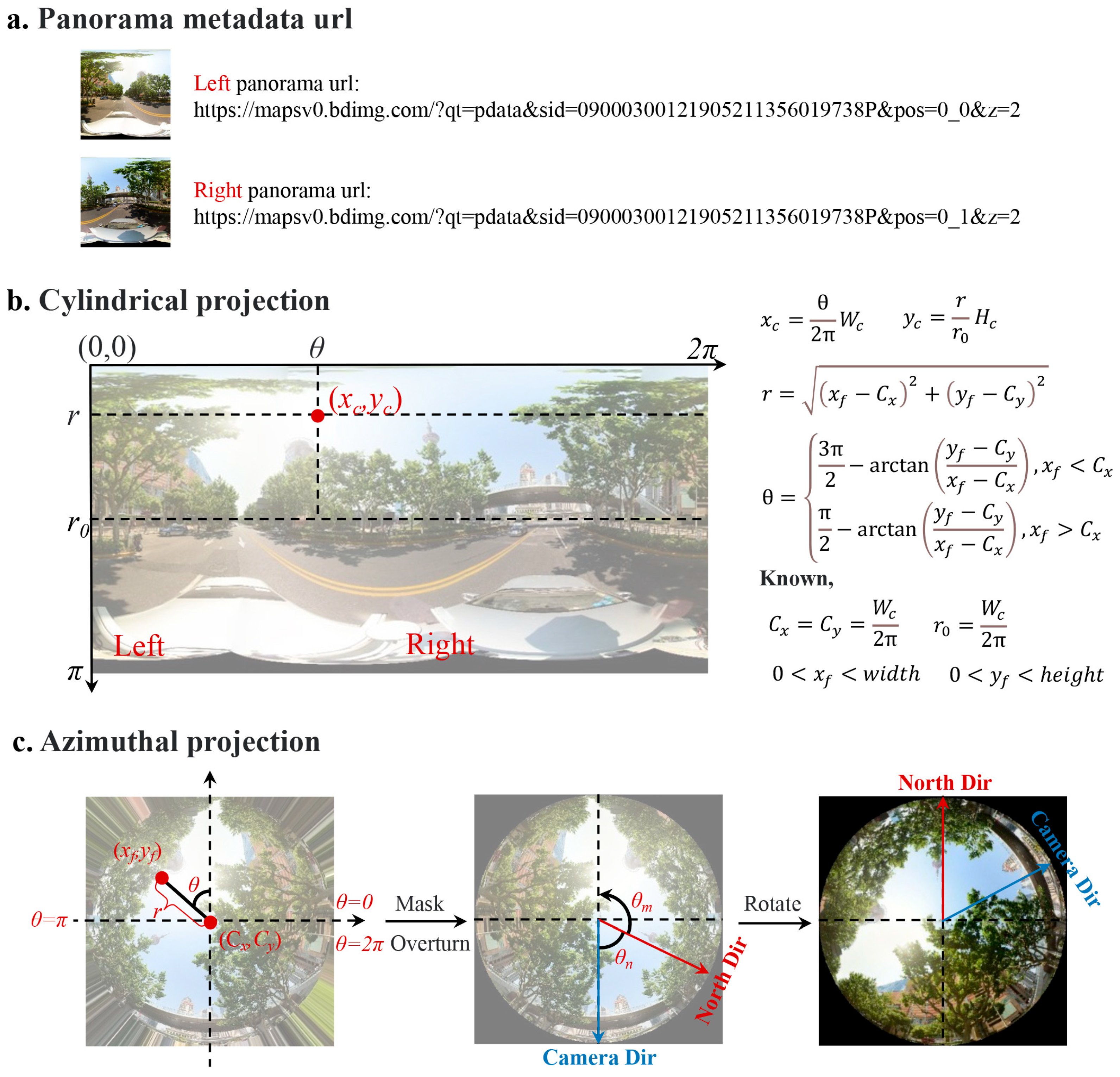
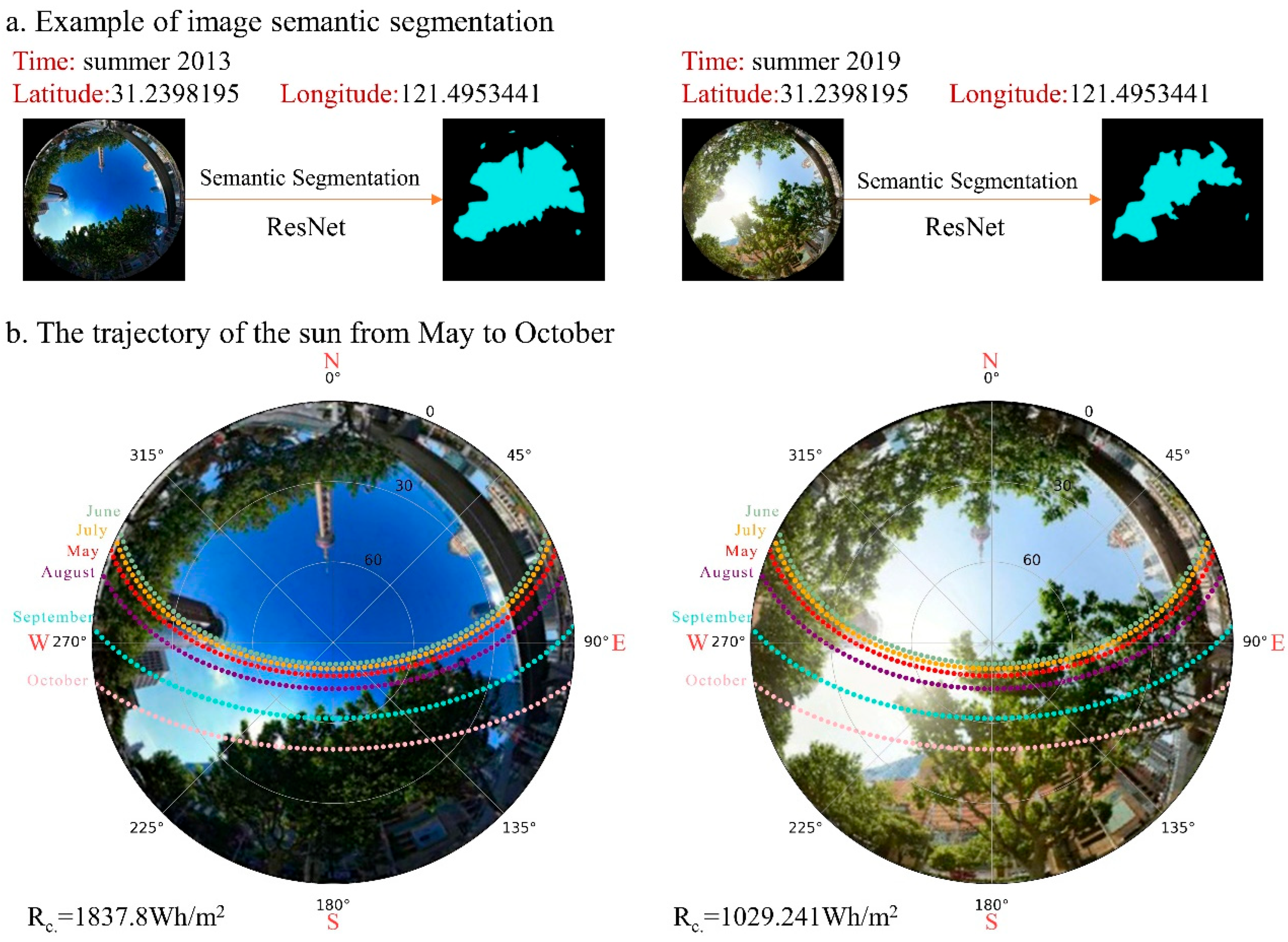
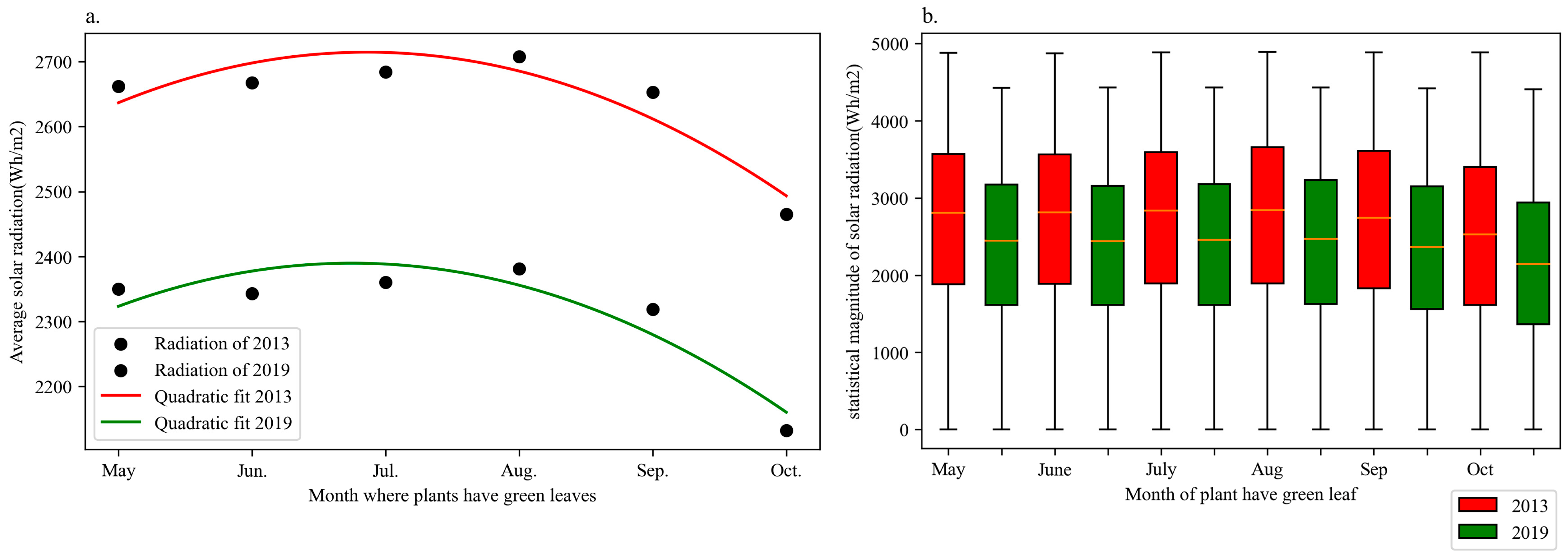
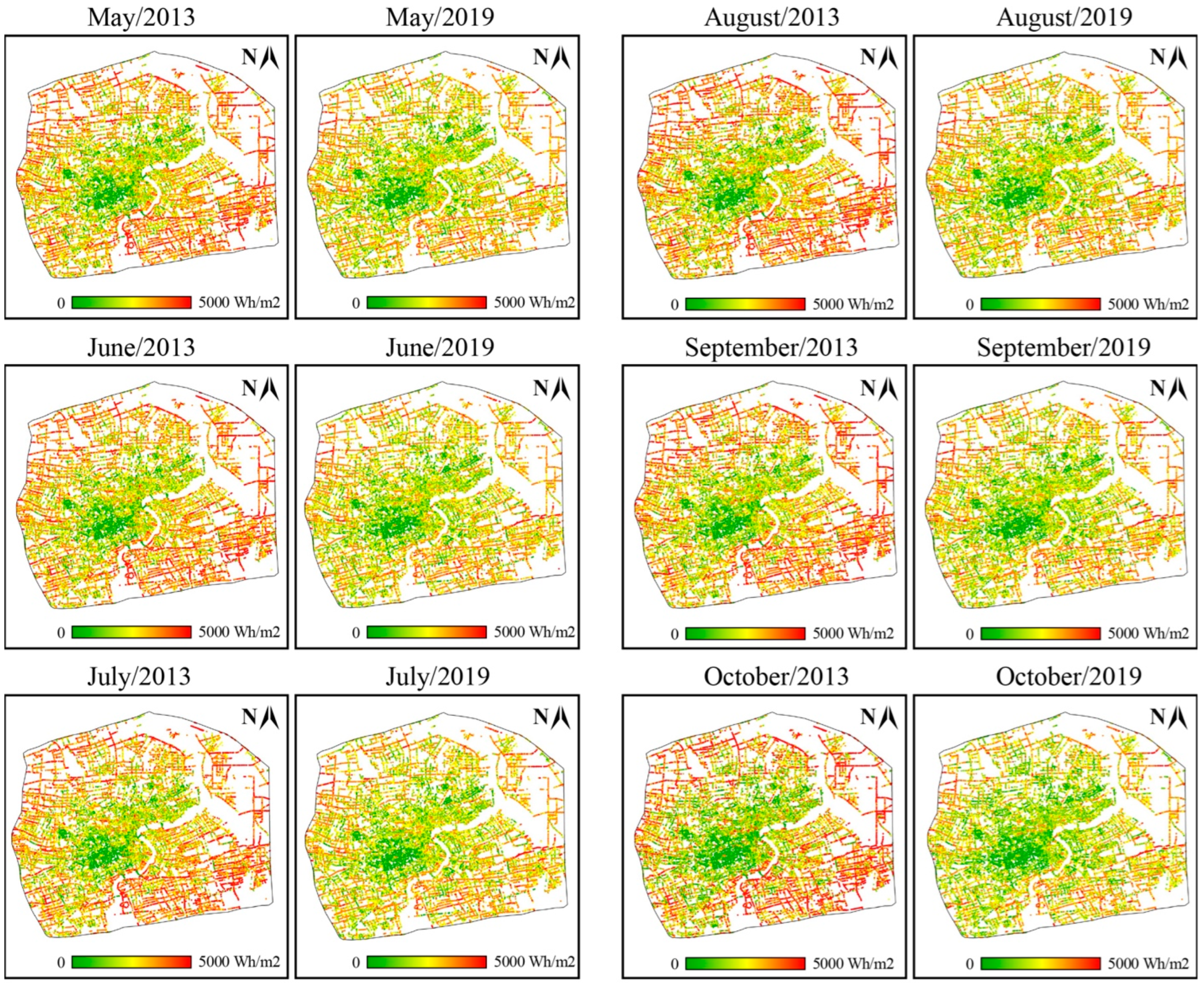
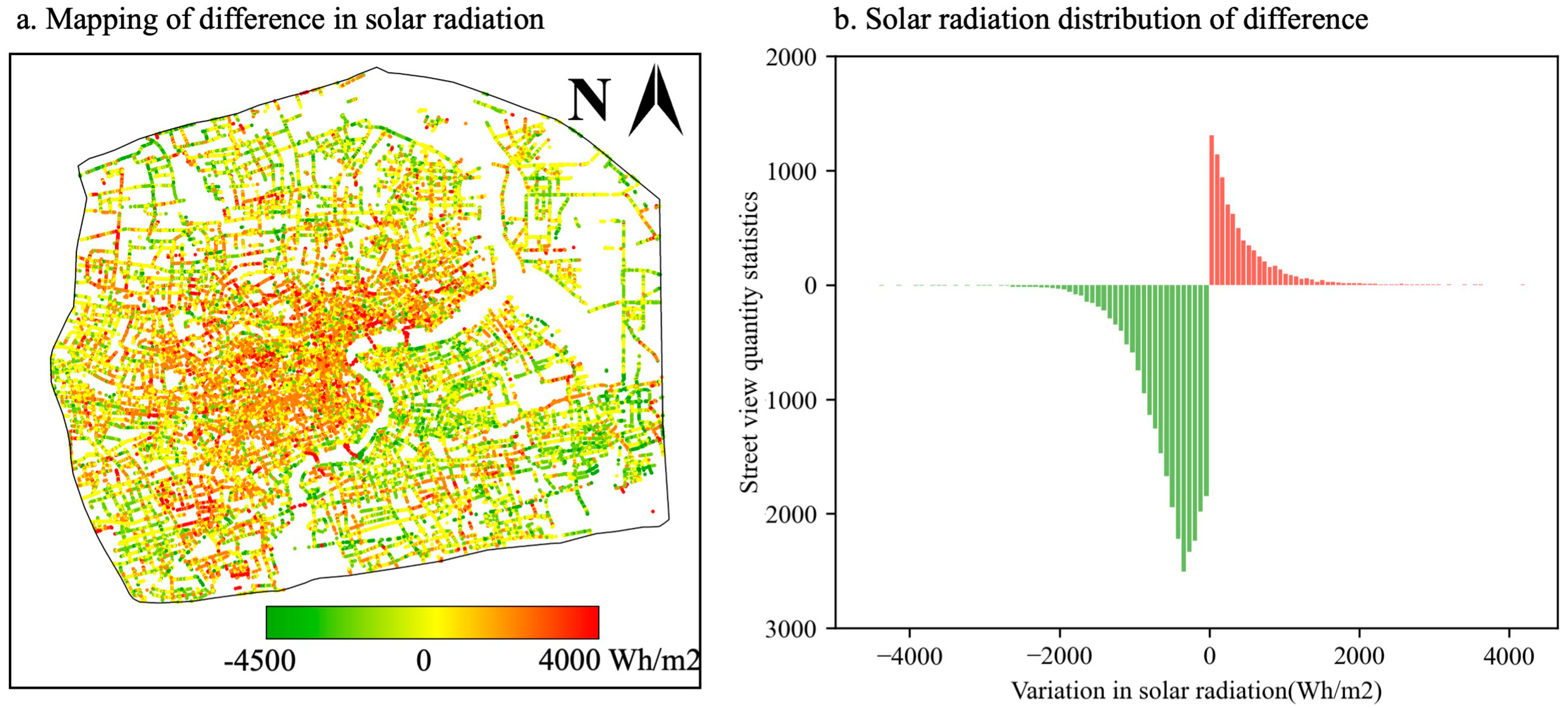


| Year/ Month | January | February | March | April | May | June | July | August | September | October | November | December | Sum |
|---|---|---|---|---|---|---|---|---|---|---|---|---|---|
| 2013 | None | None | None | None | None | None | 2468 | 4245 | 7374 | 27,234 | 4425 | 1 | 45,747 |
| 2014 | 58 | None | None | 169 | 368 | 11 | None | None | None | 48 | None | None | 654 |
| 2015 | 7072 | 6597 | 19,813 | 3025 | None | None | None | None | None | None | None | 35,697 | 72,204 |
| 2016 | 2732 | 336 | None | 40 | None | None | None | None | None | None | None | 7 | 3115 |
| 2017 | None | None | None | 170 | 2636 | 997 | 805 | 18,440 | 12,856 | 5504 | 6 | 88 | 41,502 |
| 2019 | 2141 | None | None | None | 44,892 | 3524 | 20 | None | None | None | None | 6 | 50,583 |
| 2020 | 20 | 15 | 5 | 39 | 2 | 8 | 3 | 403 | None | 12 | None | 4 | 511 |
| 2021 | None | None | None | None | None | None | None | 13 | 3 | 20 | 1 | None | 37 |
| 2022 | None | None | None | None | None | None | 8 | 3 | 12 | None | None | None | 23 |
| May | June | July | August | September | October | |
|---|---|---|---|---|---|---|
| 2013mean | 2661.77975 | 2667.53364 | 2684.58175 | 2708.04279 | 2653.12583 | 2463.95974 |
| 2019mean | 2350.05814 | 2342.77586 | 2360.06397 | 2381.18663 | 2318.69478 | 2131.96764 |
| 2013s.d. | 1128.86878 | 1131.30304 | 1139.67661 | 1155.9294 | 1160.50752 | 1164.3949 |
| 2019s.d. | 1024.75642 | 1022.5102 | 1030.35425 | 1043.9175 | 1047.22088 | 1040.27745 |
| 2013kurt | −0.6259977 | −0.5966435 | −0.6104043 | −0.6692987 | −0.7131662 | −0.8040673 |
| 2019kurt | −0.7172593 | −0.698126 | −0.7063111 | −0.7448844 | −0.7546643 | −0.8028 |
Disclaimer/Publisher’s Note: The statements, opinions and data contained in all publications are solely those of the individual author(s) and contributor(s) and not of MDPI and/or the editor(s). MDPI and/or the editor(s) disclaim responsibility for any injury to people or property resulting from any ideas, methods, instructions or products referred to in the content. |
© 2024 by the authors. Licensee MDPI, Basel, Switzerland. This article is an open access article distributed under the terms and conditions of the Creative Commons Attribution (CC BY) license (https://creativecommons.org/licenses/by/4.0/).
Share and Cite
Wang, L.; Zhang, L.; He, J. Analysing the Spatio-Temporal Variations of Urban Street Summer Solar Radiation through Historical Street View Images: A Case Study of Shanghai, China. ISPRS Int. J. Geo-Inf. 2024, 13, 190. https://doi.org/10.3390/ijgi13060190
Wang L, Zhang L, He J. Analysing the Spatio-Temporal Variations of Urban Street Summer Solar Radiation through Historical Street View Images: A Case Study of Shanghai, China. ISPRS International Journal of Geo-Information. 2024; 13(6):190. https://doi.org/10.3390/ijgi13060190
Chicago/Turabian StyleWang, Lei, Longhao Zhang, and Jie He. 2024. "Analysing the Spatio-Temporal Variations of Urban Street Summer Solar Radiation through Historical Street View Images: A Case Study of Shanghai, China" ISPRS International Journal of Geo-Information 13, no. 6: 190. https://doi.org/10.3390/ijgi13060190






